Controverscial.Com
![]()
Welcome
![]()
|
Controverscial.Com
Welcome
|
|
|
Controverscial.Com
Welcome
|



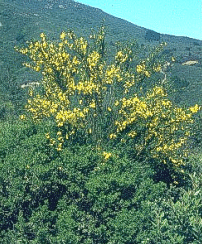
The Reed
(Cytisus scoparius) is more of a shrub plant than a tree, which in
England is better known by its folk name “Scotch Broom”.
The Reed or Broom was revered by the ancient Druids, and
is one of the sacred trees of Wicca/Witchcraft.
According to the Celtic
Tree calendar, the Reed dates from the 28th
October to the 24th November, which includes the Celtic New Year of
31st October (better known today as Samhain or Halloween).
In folklore, Reeds or Brooms symbolize purification, protection and fertility; they also
represent established power, for wands, rods and scepters made from their wood
were often carried as symbols of authority.
The
Broom is a densely growing shrub plant indigenous to England and the temperate
regions of Europe and northern Asia. It
can be being found in abundance on sandy heaths and pastures were it commonly
grows wild. In the sandy soils of
America due to its proliferation, Broom has been regulated as a “class b”
noxious weed under state law, and is designated for control in most counties of
Washington and Oregon where Local, County and State weed control boards have
regulations controlling its movement and harvest.
Broom is a member of the “Leguminosae” family, which includes beans, peas, clover, vetch, locust, lupine, acacia and alfalfa. Broom plants convert nitrogen from air that is used for growth, making them hardy and able to invade and flourish in harsh areas. The Broom is also the only native medicinal plant used as an official drug. The Latinized name “Scoparius” is derived from the Latin “scopa”, meaning “besom” (hence the common folk name broom), and “Cytisus“ is said to be a corruption of the name of the Greek island Cythnus, where the Broom once grew in abundance.
As a
young plant the Broom will often spend 2 to 4 years in a grass-like state until
it grows an extensive root system. Once
established, it can grow from 12 to 30 inches a year and attain heights of over
8 feet. Most Broom plants have a
single base with many upwardly spreading stems or branches. The stems are bright green, long, straight and slender, but
are tough and very flexible. Many
of stems are almost leafless, but those that do develop leaves, do so by late
April. Its leaves are mostly dark
green in colour and spiral up the plant’s stem from its base.
The leaves are hairy when young and the lower ones are shortly stalked
with small oblong trifoliolate leaflets. The
upper leaves near the tips of the stem are sessile, smaller and often reduced to
a single leaflet, many of which will fall off after a frost or during a severe
drought.
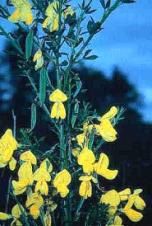
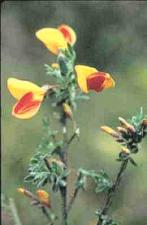
Scotch
Broom
The
flowers of the Broom are fragrant and about ¾ inch long, ranging in color from
light yellow to orange with crimson wings.
The shape of the flower is irregular with a top banner petal, two side
wing petals, and two keel petals on the bottom likened to a butterfly.
The flowers are in bloom from April to July and occur on plants as young
as 2 years old, growing more abundantly on plants of 4 years old or more.
Bees are attracted to the flowers, not in search of honey but more because
they contain an abundance of pollen.
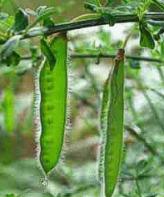
Broom
seed pods
The
flowers are followed by flat oblong seedpods about 1½ - 2 inches long, these
are hairy on the edges but smooth on the sides.
The pods are dark green or nearly black when mature and each contains
several seeds. The seeds are oval
about ⅛ inch long, dark greenish-brown and have a shiny surface.
The pods begin to dry out as the seeds inside mature and warp in
different directions, eventually they are forced open and the seeds burst out
with a sharp report landing some 4 to 12 feet away. The
continuous popping of the bursting seed-vessels can readily be heard on a hot
sunny day. The seeds have a hard shell and can remain viable in the soil
for more than 50 years before they germinate.
This long-term viability enables the Reed to re-populate areas even after
they have been cleared and even when no plants are visible on the site.
Today
there are many differing species of Brooms and the identification and naming of
them has undergone steady change, resulting in considerable confusion.
Due to the toxicity of some species it is important to recognize that
there are other Brooms, and that different names for the same plants can be
found. There are also a great
number of Brooms grown for ornamental purposes.
Some of the more common Brooms are:
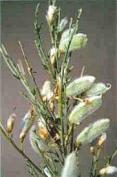
Portuguese
Broom
Portuguese
Broom (Cytisus
striatus), this is a Scotch Broom look-a-like except for the seedpods.
These are inflated and hairy all over giving the plant the appearance of
being covered with pussy willow buds. Its
stems are more silvery, but this is difficult to distinguish until after its
leaves and flowers fall off.
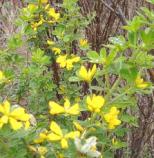
French
Broom
French
Broom (Genista
monspessulana), these are very leafy and retain their leaves the entire
year. All its leaves are
trifoliolate, whereas Portuguese and Scotch Brooms have simple leaves or
trifoliolate leaves only on the lower part of the plants.
Its flowers are yellow but smaller than those of the Scotch Broom, and
appear well before-in March and April. The
stems are finer and not as erect as those of Scotch Broom.
The Genista species of Broom is the one most referred to in ancient
texts.
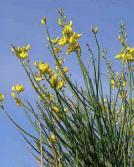
Spanish
Broom
Spanish
Broom (Spartium
junceum), this plant is the most drought-resistant of the Broom species.
It has coarse thick stems that are round and almost leafless.
Its flowers are similar in size to Scotch Broom but less numerous.
The
broom is such a versatile plant that it has many uses. It is commonly planted on the sides of steep banks were its
roots serve to hold the earth together. On
some parts of the coast it is one of the first plants to grow on sand dunes,
together with the stems of mat grasses and other sand-binding plants.
Broom will flourish within reach of sea spray, and like gorse, is a good
sheltering plant for seaside growth. Inland
it is grown extensively as shelter for game, and is one of the more important
species of shrubs used to protect them and other small animals from the wind and
weather.
The
broom seldom grows large enough to furnish useful wood, but when its stems
acquire a sufficient size, it is beautifully veined and being hard provides
valuable material for veneering. As
it’s name suggests, it was popularly used for making brooms and brushes, and
was commonly used for basketwork, especially on the island of Madeira.
In the north of England and Scotland it was used for thatching cottages
and making fences or screens.
The bark
of the Broom yields excellent fiber, which is finer than but not so strong as
the Spanish Broom. The bark is
easily separated from the stem by simply macerating them in water.
This has been done since ancient times, and from its fibers paper and
cloth was manufactured. The fibres were also used to make quill-pens as used
by old scribes. The
bark contains a considerable amount of tannin, which can be used for tanning
leather. The leaves and young
tip’s of the Broom produce a green dye that was once used to colour clothes
and garments.
The Reed
or Broom has always been associated with music, for since time began pipes and
flutes were made from reeds. In
mythology we see a connection to reeds through the panpipes of the Greek god Pan
(Roman god Faunus). In legend Pan
had a contest with Apollo to determine who could play the most skillful and
sweetest music, Pan on his reed pipes or Apollo on his lyre. Pan was judged to be the winner, which Apollo considered an
insult. In rage Apollo turned Pan
into half a man and half a goat. In
art, Pan is often depicted with the legs, horns and beard of goat.
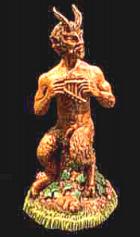
Greek
God Pan
To the
Greeks Pan was a god of the woodlands, pastures, herds and fertility.
Hills, caves, oaks, reeds and tortoises are all sacred to him.
In another legend Pan fought with the gods of Olympus during their battle
against the Titans, as the battle raged he fashioned a giant seashell into a
trumpet and raised such a noise with it, the Titans thought they were being
attacked by a sea monster and fled in terror.
The word “panic” is said to have come from this myth.
Pan is
thought to be the offspring of Hermes, whose cult was centered in Arcadia were
he haunted the woodlands, hills and mountains.
After sleeping at noon, Pan would then dance through the woods playing
the panpipes. Pan was a lusty
leader of satyrs and loved nothing better than chasing nymphs; from this he
became associated with Dionysus/Bacchus. Pan’s
symbol was the phallus, and of old he was invoked for the fertility of flocks or
an abundant hunt. Every region in
Greece had its own Pan, who was known by various names, and eventually he came
to symbolize the universal god of nature, the Horned God.
In
folklore the Pied Piper of Hamelin played a magickal tune on a pipe made from
reeds, and rid the town of a plague of rats.
As the story goes, in 1284 the Pied Piper was hired to rid the town of
Hamelin of a plague of rats. He
walked through the streets playing a magickal tune on his pipe, and on hearing
the music all the rats followed him. The
piper led the rats all the way to the banks of the river Weser, where all the
rats fell in and were drowned. Although
the town council had agreed to pay the piper, they changed their minds once the
task was done and refused to pay him.
In
retaliation the piper walked the streets again, only this time he played a
different tune on his pipe. On
hearing the music all the children in the town follow him as he led them out of
town and into the foothills of the mountains.
As they approached a door in the side of the mountain opened and the
piper and all the children vanished never to be seen again.
After their disappearance the spirits of the piper and children forever
haunted the town of Hamelin. From
this story the magickal qualities of the reed and music can be discerned.
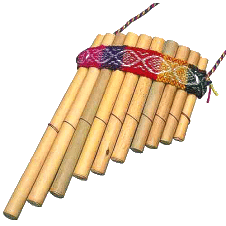
Pan
Pipes
Throughout
history the Broom has featured as a heraldic device, and was adopted at a very
early period as the badge of Brittany. Geoffrey
the 5th count of Anjou thrust it into his helmet at the moment of going into
battle so that his troops might see and follow him.
As he plucked it from a steep bank which its roots had knitted together,
he is reputed to have said: “This
golden plant rooted firmly amid rock, yet upholding what is ready to fall, shall
be my cognizance. I will maintain
it on the field, in the tourney and in the court of justice”.
From
Geoffrey of Anjou and his wife the empress Matilda, daughter of the English king
Henry I, the Plantagenet royal dynasty began.
However, the name Plantagenet was not hereditary and is thought to have
originated from his nickname, given after the sprig of broom he wore in his hat
or to his practice of planting brooms to improve his hunting covers.
The old Medieval Latin name for broom was “Planta genista”;
from which it is thought Plantagenet was derived.
The broom is depicted on the Great Seal of Richard I, this being its
first official heraldic appearance in England.
Some
historians differ on the naming of Kings as Plantagenet, some giving the name to
Count Geoffrey’s descendants beginning with Edward I.
Richard Plantagenet or Richard 3rd Duke of York was the first to use the
surname officially when he claimed the throne in 1460.
The Plantagenet dynasty ended when the last legitimate male heir, Edward
Earl of Warwick was executed in 1499.
Another
origin is claimed for the heraldic use of the broom in Brittany, in that a
prince of Anjou assassinated his brother and seized his kingdom.
Overcome by remorse he made a pilgrimage to the Holy Land in expiation of
his crime. Every night on the
journey he scourged himself with a brush of “genets” or “genista”, and
adopted the plant as his badge in perpetual memory of his repentance.
St.
Louis of France continued the heraldic use of the broom as a symbol of chivalry
and honour, and on the occasion of his marriage in the year 1234 he founded a
special order called the “Colle de Genet”. The collar of the order was decorated alternately of the
fleur-de-lis of France and a broom-flower.
His bodyguard of a hundred nobles also wore on their coats a broom-flower
emblem with the motto “Exaltat humiles” (“He exalteth the
lowly”). The order was held in
high esteem, and to be bestowed with it was regarded as a great honour. King Richard II was honoured with it, and a broom plant with
open empty pods can be seen ornamentally decorating his tomb in Westminster
Abbey. In 1368 Charles V of France
bestowed the insignia of the broom pod on his favourite chamberlain, and in 1389
Charles VI gave the same decoration to his kinsmen.
In
Scotland the broom is the badge of the Forbes clan, and according to Scottish
lore: “it was the bonny broom
which the Scottish clan of Forbes wore in their bonnets when they wished to
arouse the heroism of their chieftains”.
In the Gaelic dialect of the highlands they called the broom “bealadh”
in token of its beauty: “This
humble shrub was not less distinguished than the Rose herself during the civil
wars of the fourteenth century”.
Apart
from its use in heraldry, the Broom has been associated with several popular
traditions. In some parts it used
to be considered a sign of plenty and fertility, for it bore many flowers and
flourished quickly. The flowering
tops were used for house decoration at the Whitsuntide festival, but it was
considered unlucky to use them for menial purposes when in full bloom.
In Christianity when Joseph and the Virgin Mary were fleeing into Egypt,
the broom was cursed by Mary for the popping noises made by the pods as they
touched them in passing, increased the risk of drawing attention to their
whereabouts from Herod’s soldiers.
The
properties of Broom as a healing herb was well known to the ancients, and such
early writers as Virgil (70-19 BC) and Pliny the Elder (23-79 AD) speak of the
“Genista” species of Broom. It
was also mentioned in some of the earliest printed Herbals, such like:
the Passau (1485), the Hortus Sanitatis (1491) and the Grete Herball
(1516). John Gerard in his Herbal
of 1597 tells us: “The decoction of the twigs and tops of broom doth cleanse
and open the liver, milt and kidnies”.
The
Broom is also mentioned in the first London Pharmacopoeia of 1618, from which Nicholas
Culpepper (1616-1654)
made an unauthorized translation published
in 1649 was called “A Physicall Directory”. Later in his celebrated Herbal “The English Physician” (1652), Culpepper
considered a decoction of Broom to be good not only for dropsy, but also for
black jaundice, ague, gout, sciatica and various pains of the hips and joints.
The
flowers of broom were used for making an unguent to cure the gout.
Henry VIII used to drink a water infusion made from the flowers of Broom,
and being purgative he believed it acted as a guard against his overindulgences.
A decoction of Broom is recommended in herbal medicine for bladder and
kidney afflictions, as well as for chronic dropsy.
Bruised seeds after being infused in rectified spirit was allowed to
stand for two weeks and strained, then taken daily in a glass of peppermint
water to cure liver complaints and ague. The
seeds were also used as a substitute for coffee.
Broom
juice in large doses can disturb the stomach and bowels, and is therefore more
often used as an auxiliary to other diuretics, rather than used alone.
Called (Infusum Scoparii) it is made by infusing the dried tops of
Broom in boiling water for fifteen minutes and then straining.
It was introduced into the British Pharmacopoeia of 1898 and replaced the
decoctions of broom in the preceding issues.
Regardless
of what you read in books and articles such as this, before using any plant,
herb or spice for medicinal purposes, specialized or professional advice should
be sort. Experimentation is not an
alternative to be considered when dealing with toxic plants.
Ritual
wands made from Broom are used in purification and protection spells, and if
working outdoors (the best place to perform magic) sweeping the ground with a
brush of Broom (if it grows nearby) will clear the area of unwanted influences.
To raise the winds, throw some Broom into the air while invoking the
spirits of the Air, and to calm the winds burn some Broom and bury the ashes.
Of old,
Broom was hung up in the house to keep all evil influences out, and an infusion
of Broom sprinkled throughout the house was used to exorcise poltergeist
activity. An infusion of Broom was
also drunk to increase psychic powers and awareness through its intoxication
properties, but this is no longer recommended as the plant can also be
poisonous.
The
Broom is known by many folk names: Banal,
Basam, Besom, Bisom, Bizzon, Breeam, Broom Tops, Brum, Genista, Green Broom,
Irish Broom, Link, Scotch Broom and Hog Weed.
Its gender is Masculine. Its
planet association is with Mars. Its
element association is Air. Its
deity associations are with: Pan,
Hermes, Apollo and Dionysus/Bacchus. It
is used to attract the powers needed for: Purification,
Protection, Fertility, Wind, Divination and all spells associated the element
Air.
Astrologically
people born between the 28th October and the 24th
November, are
practical people who enjoy making themselves useful to others.
They will often be found organizing charity or other events.
They love to use their hands and are not afraid to get them dirty, and
have always been good at handicrafts. Others
are attracted to them for their artistic abilities, and they can also be very
imaginative.
![]()
Cunningham's Encyclopedia Of Magical Herbs - By Scott Cunningham.
Encyclopedia of Wicca & Witchcraft - By Raven Grimassi.
The Encyclopedia of Witches & Witchcraft - By Rosemary Ellen Guiley.
Tree Wisdom (The definitive guidebook to the myth, folklore and healing power of Trees) - By Jacqueline Memory Paterson.
AA Book of Britain's Countryside.
The Penguin Hutchinson Reference Library (CD cassette).
Microsoft Encarta Encyclopedia (CD cassette).
Plus many websites to numerous to mention.
First published in 2002 - Updated the Oct 2008 © George Knowles
![]()
![]()

Let there be peace in the world - Where have all the flowers gone?
My Personal Page / My Place in England, UK / My Family Tree (Ancestry)
Wicca/Witchcraft / What is Wicca / What is Magick
Traditional Writings:
Wiccan Rede / Charge of the Goddess / Charge of the God / The Three-Fold Law (includes The Law of Power and The Four Powers of the Magus) / The Witches Chant / The Witches Creed / Descent of the Goddess / Drawing Down the Moon / The Great Rite Invocation / Invocation of the Horned God / The 13 Principles of Wiccan Belief / The Witches Rede of Chivalry / A Pledge to Pagan Spirituality
Correspondence Tables:
Incense / Candles / Colours / Magickal Days / Stones and Gems / Elements and Elementals
Traditions Part 1 - Alexandrian Wicca / Aquarian Tabernacle Church (ATC) / Ár Ndraíocht Féin (ADF) / Blue Star Wicca / British Traditional (Druidic Witchcraft) / Celtic Wicca / Ceremonial Magic / Chaos Magic / Church and School of Wicca / Circle Sanctuary / Covenant of the Goddess (COG) / Covenant of Unitarian Universalist Pagans (CUUPS) / Cyber Wicca / Dianic Wicca / Eclectic Wicca / Feri Wicca /
Traditions Part 2 - Gardnerian Wicca / Georgian Tradition / Henge of Keltria / Hereditary Witchcraft / Hermetic Order of the Golden Dawn (H.O.G.D.) / Kitchen Witch (Hedge Witch) / Minoan Brotherhood and Minoan Sisterhood Tradition / Nordic Paganism / Pagan Federation / Pectic-Wita / Seax-Wica / Shamanism / Solitary / Strega / Sylvan Tradition / Vodoun or Voodoo / Witches League of Public Awareness (WLPA) /
Gods and Goddesses (Greek
Mythology) / Esbats &
Full Moons / Links
to Personal Friends & Resources / Wicca/Witchcraft
Resources / What's a spell? /
Circle Casting and
Sacred Space / Pentagram
- Pentacle / Marks
of a Witch / The Witches
Power / The Witches Hat
/ An
esoteric guide to visiting London / Satanism
/ Pow-wow
/ The
Unitarian Universalist Association / Numerology: Part 1
/ Part 2 / Part
3 / A
history of the Malleus Maleficarum: includes: Pope
Innocent VIII /
The
papal Bull /
The
Malleus Maleficarum /
An extract from the Malleus Maleficarum
/ The letter of approbation
/ Johann
Nider’s Formicarius /
Jacob
Sprenger /
Heinrich Kramer /
Stefano Infessura
/ Montague Summers /
The Waldenses
/ The Albigenses
/
The Hussites / The
Sun Dance
/ Shielding (Occult
and Psychic Protection) /
Sabbats in History and Mythology / Samhain (October 31st) / Yule (December 21st) / Imbolc (February 2nd) / Ostara (March 21st) / Beltane (April 30th) / Litha (June 21st) / Lughnasadh (August 1st) / Mabon (September 21st)
Rituals contributed by Crone: Samhain / Yule / Imbolc / Ostara / Beltane / Litha / Lammas / Mabon
Tools of a Witch / The Besom (Broom) / Poppets and Dolls / Pendulums / Cauldron Magick / Mirror Gazing
Animals in Witchcraft (The Witches Familiar) / Antelope / Bats / Crow / Fox / Frog and Toads / Goat / Honeybee / Kangaroo / Lion / Owl / Phoenix / Rabbits and Hares / Raven / Robin Redbreast / Sheep / Spider / Squirrel / Swans / Wild Boar / Wolf / Serpent / Pig / Stag / Horse / Mouse / Cat
In Worship of Trees - Myths, Lore and the Celtic Tree Calendar. For descriptions and correspondences of the thirteen sacred trees of Wicca/Witchcraft see the following: Birch / Rowan / Ash / Alder / Willow / Hawthorn / Oak / Holly / Hazel / Vine / Ivy / Reed / Elder. Also see: The Willow Tree (Folk Music)
Mystical Sacred Sites - Stonehenge / Glastonbury Tor / Malta - The Hypogeum of Hal Saflieni / Avebury / Cerne Abbas - The Chalk Giant / Ireland - Newgrange /
Rocks and Stones:
Stones - History, Myths and Lore
Articles contributed by Patricia Jean Martin: / Apophyllite / Amber / Amethyst / Aquamarine / Aragonite / Aventurine / Black Tourmaline / Bloodstone / Calcite / Carnelian / Celestite / Citrine / Chrysanthemum Stone / Diamond / Emerald / Fluorite / Garnet / Hematite / Herkimer Diamond / Labradorite / Lapis Lazuli / Malachite / Moonstone / Obsidian / Opal / Pyrite / Quartz (Rock Crystal) / Rose Quartz / Ruby / Selenite / Seraphinite / Silver and Gold / Smoky Quartz / Sodalite / Sunstone / Thunderegg / Tree Agate / Zebra Marble
Wisdom:
Knowledge vs Wisdom by Ardriana Cahill / I Talk to the Trees / Awakening / The Witch in You / A Tale of the Woods
Articles and Stories about Witchcraft:
Murder by Witchcraft / The Fairy Witch of Clonmel / A Battleship, U-boat, and a Witch / The Troll-Tear (A story for Children) / Goody Hawkins - The Wise Goodwife / The Story of Jack-O-Lantern / The Murder of the Hammersmith Ghost / Josephine Gray (The Infamous Black Widow) / The Two Brothers - Light and Dark
Old Masters of Academia:
Pliny the Elder / Hesiod / Pythagoras
Abramelin the Mage / Agrippa / Aidan A. Kelly / Albertus Magnus “Albert the Great” / Aleister Crowley “The Great Beast” / Alex Sanders "the King of the Witches” / Alison Harlow / Amber K / Anna Franklin / Anodea Judith / Anton Szandor LaVey / Arnold Crowther / Arthur Edward Waite / Austin Osman Spare / Biddy Early / Bridget Cleary / Carl Llewellyn Weschcke / Cecil Hugh Williamson / Charles Godfrey Leland / Charles Walton / Christina Oakley Harrington / Damh the Bard (Dave Smith) / Dion Fortune / Dolores Aschroft-Nowicki / Dorothy Morrison / Doreen Valiente / Edward Fitch / Eleanor Ray Bone “Matriarch of British Witchcraft” / Dr. John Dee and Edward Kelly / Dr. Leo Louis Martello / Eliphas Levi / Ernest Thompson Seton / Ernest Westlake and the Order of Woodcraft Chivalry / Fiona Horne / Friedrich von Spee / Francis Barrett / Gerald B. Gardner / Gavin and Yvonne Frost and the School and Church of Wicca / Gwydion Pendderwen / Hans Holzer / Helen Duncan / Herman Slater "Horrible Herman" / Israel Regardie / James "Cunning" Murrell / Janet Farrar & Gavin Bone / Jessie Wicker Bell “Lady Sheba” / John Belham-Payne / John George Hohman / John Gerard / John Gordon Hargrave (the White Fox) / John Michael Greer / John Score / Johannes Junius the Burgomaster of Bamberg / Joseph John Campbell / Karl von Eckartshausen / Laurie Cabot "the Official Witch of Salem" / Lewis Spence / Margaret Alice Murray / Margot Adler / Marie Laveau the " Voodoo Queen of New Orleans" / Marion Weinstein / Matthew Hopkins “The Witch-Finder General” / Max Ehrmann and the Desiderata / Monique Wilson the “Queen of the Witches” / Montague Summers / Nicholas Culpeper / Nicholas Remy / M. R. Sellers / Mrs. Grieve "A Modern Herbal" / Oberon and Morning Glory Zell-Ravenheart / Old Dorothy Clutterbuck / Old George Pickingill / Paddy Slade / Pamela Colman-Smith / Paracelsus / Patricia Crowther / Patricia Monaghan / Patricia “Trish” Telesco / Philip Emmons Isaac Bonewits / Philip Heselton / Raymond Buckland / Reginald Scot / Robert Cochrane / Robert ‘von Ranke’ Graves and "The White Goddess" /
Rudolf Steiner / Rosaleen Norton “The Witch of Kings Cross” / Ross Nichols and The Order of Bards, Ovates & Druids / Sabrina - The Ink Witch / Scott Cunningham / Selena Fox / Silver Ravenwolf / Sir Francis Dashwood / Sir James George Frazer / S.L. MacGregor Mathers and the “Hermetic Order of the Golden Dawn” / Starhawk / Stewart Farrar / Sybil Leek / Ted Andrews / The Mather Family - includes: Richard Mather, Increase Mather, Cotton Mather / Thomas Ady / Vera Chapman / Victor Henry Anderson / Vivianne Crowley / Walter Brown Gibson / William Butler Yeats / Zsuzsanna Budapest
Many of the above biographies are brief and far from complete. If you know about any of these individuals and can help with aditional information, please cantact me privately at my email address below. Many thanks for reading :-)
While I have taken due care and dilligence to credit all sources where possible, this website may contain copyrighted material which has not been specifically authorized by the copyright owner. My use of making such material available here is done so in my efforts to advance our understanding of religious discrimination, the environmental and social justice issues etc. If you wish to use copyrighted material from this wedsite for purposes of your own then you must obtain permission from the relevant copyright owner yourself.
![]()
My online email discussion group:
http://groups.yahoo.com/group/Email_Witches

Help send a message of peace around the world! The Dove of Peace flies from site to site, through as many countries as possible. It does not belong to ANY belief system. Please help make a line around the globe by taking it with you to your site, by giving it to someone for their site, by passing it on to another continent or to the conflict areas of the world. May trouble and strife be vanquished in it's path.

mailto:George@controverscial.com
![]()
|
|